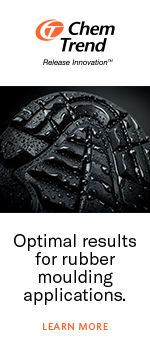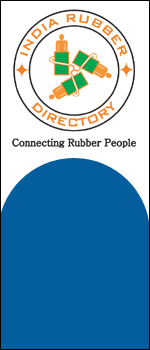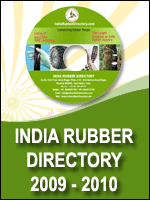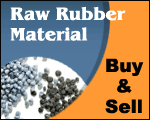
Rubber Chemicals &
additives
Significant advances in the field
of rubber compounding over the years have helped expansion of the rubber
chemical and additives manufacturing industry.
Discovery of the process of
vulcanization of rubber in 1839 by Charles Goodyear has enhanced the need
for chemical and additives (C&As) for transforming rubber into more useful
products. A large number of C&As have helped to expand the application of
rubber in variety of rubber compounding have enabled larger control over
specifically desired end-characteristics in products with substantial cost
savings in some cases. These advances have helped expansion of the rubber
C&A manufacturing industry.
A large number of C&As are
at present used for making rubber products, generally classified as
chemicals/ additives used as aids and means of curing, chemicals used as
aids means of curing. Chemicals used as aids to processing, those used as
aids to improving quality, those used as diluents, and special additives.
Curing aids and means
The
materials coming under this group comprise vulcanising agents, accelerators
and activators. Vulcanising agents function as cross-linking agents.
Sulphure is the most common among them. The normal rubber-grade sulphur is
in the rhomic form, ground so fine to pass sieve of about 200 mesh/inch.
This sulphur is soluble in carbon disulphide and chloroform and insoluble in
water.
Another grade, known as
insoluble sulphur, is also used in certain applications. This type, known
as MC sulphur, is especially suitable in butyl and nitrile mixes where good
dispersion of sulphur is necessary. In this material the Sulphure particles
are coated with about 2.5% magnesium carbonate to reduce agglomeration and
is as fine as the rhotmic form.
Several other materials are
also used as vulcanizing agents. They are: sulphur monochloride, sulphur
donors, metallic oxides, phenolic resins, pquinone dioxies, and peroxides.
Accelerators
Accelerators
are organic chemicals that reduce the time and temperature for vulcanization
of rubber. They also modify the vulcanization (curing) reaction to produce
cured (vulcanized) rubber of better quality. The different materials used
as accelerators can be classified in a variety of ways:
·
Property classification – peaky,
flat, curing, quick set-up, and delayed action.
·
Speed classification – slow,
medium, semi0ultra (fast-medium) and ultra (fast).
·
Chemical classification – aldehyde
reaction products such as amines, guanidines, thioureas, thiozoles, thiurams,
sulphanamides, dithiocarbamates and xanthates.
Activators
These chemicals activate
vulcanization reaction. In other words, they trigger the accelerator and
increase the vulcanization rate. Activators in common use are classified
into three groups as below:
·
Inorganic compounds: Metal oxides
such as zinc oxides, hydrated time, litharge, manganese, red lead, alkali
carbonates and hydroxides.
·
Fatty acids: Usually
high-molecular weight monobasic acids or mixtures of the following types-stearic,
oleic, lauric, palmitic acids-and hydrogenated oils- palm, gastor, fish and
linseed oils.
·
Amines (alkaline substances):
Diethanol amine, triethanol amine.
Processing materials
The materials used as aids to
processing are known as Plasticisers/softeners and extenders. Plasticisers
are used to increase to plasticity and workability of the rubber compound,
to aid the wetting and incorporation of fillers, provide lubrication, to
improve extrusion, moulding or other shaping operations, reduce batch
temperature and power consumption during mixing, and to modify the
properties of rubber products.
They are divided broadly
into two chemical and physical Plasticisers. The former acts by reducing
the rubber’s molecular weight by “chain session” and the latter acts as an
intermolecular lubricant.
Chemical plasticiser are
quite different from one another and are effective under different
conditions. Some of them are: Aromatic mercaptans (eg. Thionaphthol and
xylyl mercaptan) which have a strong softening effect on NR and reclaim
rubber: phenyl hydrazine salts, thiuram disulphides, benezamide-diphenyl
disulphide, petroleum sulphonates and paentachloro-thiophenol.
Most of the important
physical Plasticisers come from any one of the following sources: Petroleum
(mineral oils, resins and waxes), pine tree (pinetar, pitch, resins), coal
tar (tar oil, pitch and resins), natural fats and oils (vegetable oil, blown
oils, fatty acids), and synthetic organic compounds.
Petroleum oils are the most
common among the above. They range from highly aromatic naphtenic to
paraffinic oils. All these are produced in various grades of viscosity and
staining power.
Extenders
These
are substances added to rubber compounds in large quantities to reduce cost,
without seriously affecting the final properties. The most important
commercially used extenders are relaimed rubber (RR) and Factice. Use of RR
as an extender has economic advantages and other advantages such as short
mixing time, jow power consumption. Low heat development, reduced swelling
and shrinkage, reduced swelling and shrinkage, good ageing etc.
Factice is a class of
elastic gum made by reacting certain unsaturated, vegetable oils with
sulphur. Factice can be blended with NR and with some synthetic rubbers in
rather high proportions and the blend will remain highly elastic.
Quality-enhancers
Reinforcing fillers (RFs) and
antioxidants come under this group. The RFs can be broadly divided into two
categories: a) Carbon blacks, silica and silicates of aluminum and calcium;
b) Semi-reinforcing hared clays, activated calcium carbonates, magnesium
carbonates etc.
Among the RFs used in the
rubber industry, a lion’s share is constituted by different types of carbon
blacks.
Carbon blacks
Carbon blacks (CBs) are
essentially carbon prepared by converting liquid or gaseous hydrocarbons
into elemental carbon by partial combustion or thermal decomposition.
Depending on the process adopted for the preparation, CBs are grouped as
furnace blacks, thermal blacks, channel blacks and lampblacks.
Furnace blacks are produced
by incomplete combustion of natural gas or heavy aromatic residue oils from
the petroleum industry, in refractory lined steel furnaces and separating
the carbon by means of filter bags. They are pelletised and packed.
In the thermal process,
natural gas or oil is thermally decomposed at about 1300 deg. C
in the absence of free air,
in a cylindrical furnace filled with an open checker work of silica bricks.
The channel blacks are
produced by feeding natural gas or oil into thousands of small burner tips
where the small flames impinge either on a large rotating drum or onto
reciprocating channel irons. The blacks deposited is scraped and
collected.
Lamp black is made by
burning oil and allowing the black formed to settle down by gravity in a
series of chambers.
The commercially available
carbon blacks used in rubber products manufacture are the following.
Name
Abbreviations ASTM D1765 Number
Intermediate super-
Abrasion
furnace ISAF
N-220
Easy
processing EPC
S-300
Channel
High abrasion
furnace HAF N-330
Fine
furnace
FF N-440
Fast extrusion
furnace FEF N-550
General
Purpose GPF
N-660
Furnace
Semi-reinforcing
furnace SRF N-770
Fine
thermal
FT N-880
Medium
thermal MT
N-990
Different grades of CB
available are now considered the most versatile RFs for the rubber
industry.
Non-black RFs
For
reinforcement purpose, a number of non-black fillers can also be used.
Among the non-black RFs, the best is precipitated silica. Calcium silicate
and chemically altered clay would be next in line, followed by ultrafine
carbonates and hard clay.
Chemicals and additives used as diluents
A number of materials are used
in the rubber industry as diluents. They are generally termed as
non-reinforcing fillers. The most important among them are the following:
Whiting, soft clays,
barites and ithopone. Among these, whiting (mineral calcium carbonate) is
the most important filler used in high loading in low cost compounds. Soft
clays which are of white powder are also used at high loading for low cost
of coloured mechanical goods. Barytes is a very high sp.gravity (4.5)
material used as an inert filler particularly in chemical and acid (sulphuric)
resistant tanks lining. Lithophone is a mixture of zinc sulphide and barium
sulphate (precipitated).
Special materials
A
number of materials generally termed as miscellaneous compounding
ingredients are used in the rubber industry for manufacturing products
requiring specific property. A few typical examples are given below:
Function Example
A brasive Pumice (ground) Ground glass
Blowing agent DNPT (DI
nitroso pentamethy lene tetramine)
Colourants titanium dioxide
(white) phthalocyanine blue (blue) iron oxide (red)
Flame retarder antimony
oxide, chlorinated paraffin
Odorants methyl, salicylate,
vanilla, lemon grass oil.
Promoter p-dinitrosobenzene
Retarder N-nitroso dipheny
lamine salicy acid
Antimildew agent ortho
phenyl phenol
Antioxidants condensation
product of acetone and dipheny lamine phenyl-beta-napthy lamine
The details given above
show that a number of chemicals/ additives are used of make rubber
products. The industries manufacturing these chemicals/additives are known
as rubber chemicals/additives manufacturing industries.
Back

























